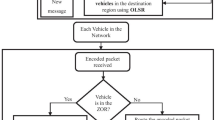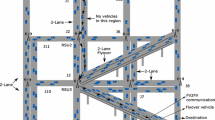Abstract
Geocast routing is one of the most investigated choices for reliable and efficient dissemination of information because of group of vehicles sharing geographic region on the road. Most of geocast routing protocols for intermittently connected Vehicular Adhoc Networks, suffer from low packet delivery, high end-to-end delay and elevated packet loss in intermittently connected networks and low throughput, high hop-to-hop disconnection, larger hop-count in fully connected networks. In this paper, guaranteed geocast routing (GGR) protocol for intermittently connected highway traffic environment has been proposed. GGR utilizes caching and heuristic function for reliable next hop vehicle selection. It also uses FAST (group of neighboring vehicles moving at higher speed than current forwarder) in packet delivery and SLOW (group of neighboring vehicles moving at lower speed than current forwarder) in hop-to-hop failure recovery. One-hop delivery has been guaranteed through acknowledgement. The proposed protocol has been simulated using NS-2 and its performance has been compared with that of adoptive carry-store forward, spray & wait and epidemic routing protocols. Results reveal that the performance of GGR is better in terms of number of routing matrices considered for both intermittently and fully connected networks.















Similar content being viewed by others
References
Status Report on Road Safety (2013). World Health Organization (WHO). http://www.who.int/violence_injury_prevention/road_safety_status/2013/en/. Accessed 10, 2014
The statistical report 2012, Delhi Police. http://www.delhipolice.nic.in/. Accessed 13, 2014
Karagiannis, G., Altintas, O., Ekici, E., Heijenk, G., Jarupan, B., Lin, K., & Weil, T. (2011). Vehicular networking: A survey and tutorial on requirements, architectures, challenges, standards and solutions. Communications Surveys & Tutorials, IEEE, 13(4), 584–616.
Olariu, S., & Weigle, M. C. (Eds.). (2010). Vehicular networks: From theory to practice. Boca Raton: CRC Press.
Emmelmann, M., Bochow, B., & Kellum, C. (Eds.). (2010). Vehicular networking: automotive applications and beyond (Vol. 2). Hoboken: Wiley.
Hartenstein, H., & Laberteaux, K. P. (Eds.). (2010). VANET: Vehicular applications and inter-networking technologies. Chichester: Wiley.
Baiocchi, A., & Cuomo, F. (2013). Infotainment services based on push-mode dissemination in an integrated VANET and 3G architecture. Journal of Communications and Networks, 15(2), 179–190.
Omar, H. A., Zhuang, W., & Li, L. (2013). VeMAC: A TDMA-based MAC protocol for reliable broadcast in VANETs. IEEE Transactions on Mobile Computing, 12(9), 1724–1736.
Watanabe, F., Fujii, M., Itami, M., & Itoh, K. (2005). An analysis of incident information transmission performance using MCS/CDMA scheme. In Intelligent Vehicles Symposium, 2005. Proceedings, IEEE (pp. 249–254). IEEE.
Blum, Jeremy J., & Eskandarian, Azim. (2007). A reliable link-layer protocol for robust and scalable intervehicle communications. IEEE Transactions on Intelligent Transportation Systems, 8(1), 4–13.
IEEE 802.11 Working Group. (2010). IEEE standard for information technology-telecommunications and information exchange between systems-local and metropolitan area networks-specific requirements-part 11: Wireless LAN medium access control (MAC) and physical layer (PHY) specifications amendment 6: Wireless access in vehicular environments. IEEE Standard, 802. 11p.
Armstrong, L. & Fisher, W. IEEE 802.11P Wireless access for vehicular environment. Draft standard, http://grouper.ieee.org/groups/802/11/. Accessed 16, 2014
Kaiwartya, O., Kumar, S., Lobiyal, D. K., Abdullah, A. H., & Hassan, A. N. (2014). Performance improvement in geographic routing for vehicular Ad Hoc networks. Sensors, 14(12), 22342–22371.
DSRC Standards: What’s New? ITS Standards Advisory number 3. US Department of Transportation. http://www.its.dot.gov/DSRC/. Accessed 02, 2014
Kaiwartya, O., Kumar, S., Lobiyal, D. K., Tiwari, P. K., Abdullah, A. H., & Hassan, A. N. (2015). Multi-objective dynamic vehicle routing problem and time seed based solution using particle swarm optimization. Journal of Sensors, 2015, 1–14.
Rao, R. S., Soni, S. K., Singh, N., & Kaiwartya, O. (2014). A probabilistic analysis of path duration using routing protocol in VANETs. International Journal of Vehicular Technology, 2014, 1–10.
Dora, D. P., Kumar, S., & Kaiwartya, O. (2015). Efficient dynamic caching for geocast routing in VANETs. In Proceedings of the international conference on signal processing and integrated networks (SPIN-2015), 19–20 February, Noida.
Vahdat, A., & Becker, D. (2000). Epidemic routing for partially connected ad hoc networks (p. 18). Technical Report CS-200006, Duke University.
Spyropoulos, T., Psounis, K., & Raghavendra, C. S. (2005, August). Spray and wait: An efficient routing scheme for intermittently connected mobile networks. In Proceedings of the 2005 ACM SIGCOMM workshop on Delay-tolerant networking (pp. 252–259). ACM.
Lindgren, A., Davies, E., Grasic, S., & Doria, A. (2012). Probabilistic routing protocol for intermittently connected networks. Lulea University of Technology, draft-irtf-dtnrg-prophet-10. https://tools.ietf.org/html/rfc6693. Accessed 07, 2014
Pereira, P. R., Casaca, A., Rodrigues, J. J., Soares, V. N., Triay, J., & Cervelló-Pastor, C. (2012). From delay-tolerant networks to vehicular delay-tolerant networks. Communications Surveys & Tutorials, IEEE, 14(4), 1166–1182.
Kaiwartya, O., & Kumar, S. (2014, May). Geocasting in vehicular adhoc networks using particle swarm optimization. In Proceedings of the International Conference on Information Systems and Design of Communication (pp. 62–66). ACM.
Wu, D., Zhu, G., & Zhao, D. (2013). Adaptive carry-store forward scheme in two-hop vehicular delay tolerant networks. Communications Letters, IEEE, 17(4), 721–724.
Musolesi, M., & Mascolo, C. (2009). CAR: Context-aware adaptive routing for delay-tolerant mobile networks. IEEE Transactions on Mobile Computing, 8(2), 246–260.
Soares, V. N., Rodrigues, J. J., & Farahmand, F. (2014). GeoSpray: A geographic routing protocol for vehicular delay-tolerant networks. Information Fusion, 15, 102–113.
Li, F., Zhao, L., Fan, X., & Wang, Y. (2012). Hybrid position-based and DTN forwarding for vehicular sensor networks. International Journal of Distributed Sensor Networks, 2012(1), 1–10.
Niyato, D., Wang, P., & Teo, J. C. M. (2009). Performance analysis of the vehicular delay tolerant network. In Wireless Communications and Networking Conference, 2009. WCNC 2009. IEEE (pp. 1–5). IEEE.
Mershad, K., Artail, H., & Gerla, M. (2012). ROAMER: Roadside units as message router in VANETs. Ad Hoc Networks, 10(3), 479–496.
Kaiwartya, O., Kumar, S., & Kasana, R. (2013, August). Traffic light based time stable geocast (T-TSG) routing for urban VANETs. In Contemporary Computing (IC3), 2013 Sixth International Conference on (pp. 113–117). IEEE.
Kaiwartya, O., & Kumar, S. (2014). Enhanced caching for geocast routing in vehicular Ad Hoc network. In Intelligent computing, networking, and informatics (pp. 213–220). Springer India.
Wang, Z., Tameh, E. K., & Nix, A. R. (2008). Joint shadowing process in urban peer-to-peer radio channels. IEEE Transactions on Vehicular Technology, 57(1), 52–64.
Li, C., Zhao, C., Zhu, L., Lin, H., & Li, J. (2014). Geographic routing protocol for vehicular ad hoc networks in city scenarios: a proposal and analysis. International Journal of Communication Systems, 27(12), 4126–4143.
Kaiwartya, O., & Kumar, S. (2013). Cache agent based geocasting (CAG) in VANETs. International Journal of Information and Communication Technology,. http://www.inderscience.com/info/ingeneral/forthcoming.php?jcode=ijict. Accessed 12, 2014
Kaiwartya, O., & Kumar, S. (2014). Geocast routing: Recent advances and future challenges in vehicular adhoc networks. In Signal Processing and Integrated Networks (SPIN), 2014 International Conference on (pp. 291–296). IEEE.
Raw, R. S., & Das, S. (2013). Performance analysis of P-GEDIR protocol for vehicular ad hoc network in urban traffic environments. Wireless Personal Communications, 68(1), 65–78.
Fonseca, A., & Vazão, T. (2013). Applicability of position-based routing for VANET in highways and urban environment. Journal of Network and Computer Applications, 36(3), 961–973.
Lim, S., Yu, C., & Das, C. R. (2009). Cooperative cache invalidation strategies for internet-based vehicular Ad Hoc networks. In Computer Communications and Networks. ICCCN, Proceedings of 18th Internatonal Conference on (pp. 1–6). IEEE.
Chen, H., Xiao, Y., & Vrbsky, S. V. (2013). An update-based step-wise optimal cache replacement for wireless data access. Computer Networks, 57(1), 197–212.
Rich, E., Knight, K., & Nair, S. B. (2009). Artificial intelligence. New York: Tata McGraw-Hill Education Private Limited.
NS-2 Mannual. http://www.isi.edu/nsnam/ns/ns-documentation.html. Accessed 03, 2014
Chung, J. & Claypool, M. ns by example. http://nile.wpi.edu/NS/. Accessed 07, 2014
Karnadi, F. K., Mo, Z. H., & Lan, K. C. (2007). Rapid generation of realistic mobility models for VANET. In Wireless Communications and Networking Conference. WCNC, IEEE (pp. 2506–2511). IEEE.
Author information
Authors and Affiliations
Corresponding authors
Rights and permissions
About this article
Cite this article
Kaiwartya, O., Kumar, S. Guaranteed Geocast Routing Protocol for Vehicular Adhoc Networks in Highway Traffic Environment. Wireless Pers Commun 83, 2657–2682 (2015). https://doi.org/10.1007/s11277-015-2562-4
Published:
Issue Date:
DOI: https://doi.org/10.1007/s11277-015-2562-4




